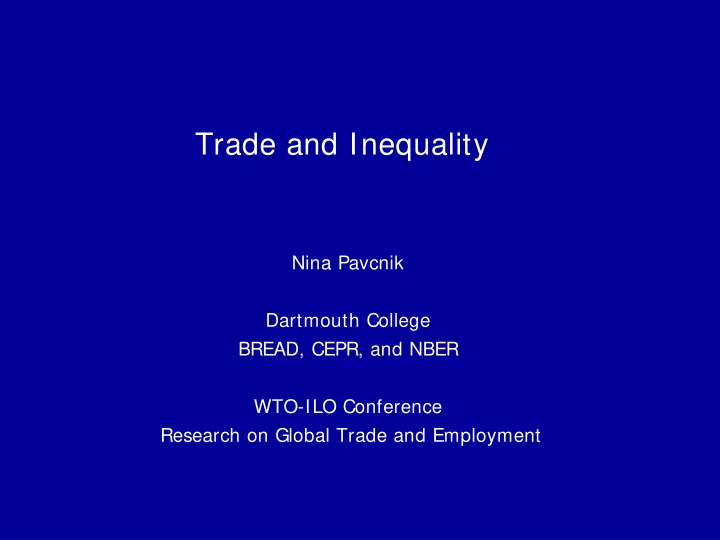

Trade and Inequality Nina Pavcnik Dartmouth College BREAD, CEPR, and NBER WTO-ILO Conference Research on Global Trade and Employment
Trade and Inequality in Developing Countries • My research background: Labor market responses to trade liberalization in developing countries ○ Survey on “Distributional Effects of Globalization in Developing ○ Countries,” Journal of Economic Literature , Goldberg and Pavcnik (2007) • Discussion of research on specific aspects of trade and inequality delegated to separate sessions Trade, firms and employment ○ Trade and informality/job quality ○ Labor market adjustment to trade reform ○ Trade and Skill upgrading ○
Goal • Trade and Inequality Researchers have made big progress toward understanding the link ○ between trade and wage inequality between educated and less educated workers in poor countries Why? Some common features of recent research design ○ Identify areas for future research ○ • Trade and poverty
Big question: trade and increasing inequality • Many developing countries liberalized international trade since 1980. • The workhorse model of trade based on endowment differences across countries suggests that less educated workers in developing countries, should benefit from reduction of trade barriers (Krueger et al: Trade and Employment in Developing Countries ) Lower poverty ○ Lower inequality ○ • Yet, wage inequality between educated and less educated (skill premium) increased in many poor countries since 1980s • This “puzzling” fact instigated a large body of research • Success toward resolving the puzzle
Research design • Empirical work guided by theory Static link between trade policy and inequality via changes in relative prices ○ and wages (empirically tractable) ○ NOT dynamic link through growth Focus on specific channels through which trade affects income ○ • Micro-level data for particular countries (firms, individuals, households) • Direct measures of trade policy/trade costs to identify the effect Reductions in trade barriers induced by large-scale trade liberalizations ○ ○ Exchange rate shocks Liberalization of Foreign Direct Investment/Trade in intermediate goods ○ • Consider the role of other reforms and cofounding factors
Explanations for increased wage inequality • SBTC or trade-induced SBTC • But trade based on relative endowment differences between rich and poor countries plays some role. ○ Not trade based on differences in the use of skilled labor across industries ○ Little reallocation of employment across industries. ○ Increase in the relative demand for educated within rather than across industries Trade induces changes in relative demand for educated labor within ○ industries Factor proportions differences across stages of production Feenstra and Hanson ○ (1997,1999) Factor proportions differences across firms within an industry Bernard and ○ Jensen (1995, 1997)
Ongoing and Future Research: Residual wage inequality • Most research focuses on wage differences between educated and less educated workers • Large part of increased wage inequality attributed to inequality of wages of workers with same observable characteristics (i.e. residual wage inequality) • Does trade contribute to changes in residual wage inequality? Industry wage premium (trade matters, but magnitudes small) ○ Heterogeneity in wages across firms within an industry (session 2) ○ Driven by productivity differences across firms ○ Yeaple (2005), Kaplan and Verhoogen (2005), Verhoogen (2008), Bustos (2005), BRS (2007), ○ Amiti and Davis (2008), Davis and Harrigan (2007), HIR (2009 ) Unobserved worker heterogeneity ○
Trade and Poverty • Higher wage inequality does not necessarily imply higher poverty • Difficult to draw conclusions about trade and poverty Studies on trade and inequality often based on data that cover ○ individuals employed in the “formal” sector living in urban areas Poor: less educated worker in formal manufacturing sector ○ Don’t capture populations most vulnerable to poverty ○ Unemployed ○ Individuals working in “informal” sector, smaller firms ○ Individuals not working for wages ○ Individuals living in rural areas ○
Existing research on trade and poverty • An emerging literature examines the direct effect of trade on poverty (Porto (2004), Goldberg and Pavcnik (2007), Topalova (2005), McCaig (2008), Mitra, et. al. (2007)) • Analysis relies on household level data that overcomes some of measurement challenges • The effect of trade on poverty depend on The nature of trade reform ○ Institutional context in which reform takes place ○ ○ Mobility constraints on individuals
Ongoing and Future Research: Trade and Poverty • Need to better understand the underlying mechanisms • Examine how particular phenomena that are highly correlated with poverty are affected by recent trade liberalization episodes: Absolute wages (as opposed to relative wages) ○ Unemployment ○ Employment in the informal sector, small firms ○ Compliance with labor standards (minimum wage in particular) ○ Relative prices of goods consumed primarily by the poor ○ • The role of mobility across geographic regions/industries/firms within a country Trade associated with increases in poverty in areas with high concentration ○ of previously protected industries (Topalova (2005)) or no effects on poverty (Goldberg and Pavcnik (2007), Mitra et. al. (2007) Trade associated with declines in poverty in areas benefiting from export ○ boom (McCaig (2008)) ○ What inhibits people from moving toward new economic opportunities?
Ongoing and Future Research: Trade and Poverty • So far, my comments focused on static effects of trade on poverty via changes in employment, wages and prices • Dynamic effects of trade on poverty via growth
Recommend
More recommend